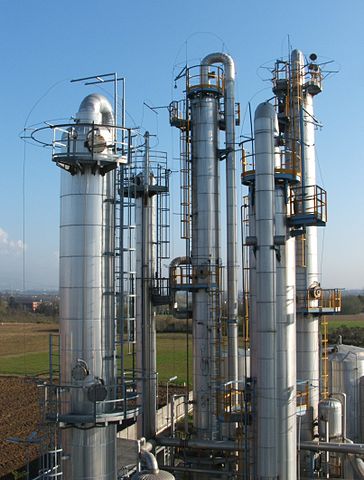# # Binary Distillation with McCabe-Thiele
# ## Summary
#
# This notebook illustrates the the design of binary distillation columns using the McCabe-Thiele graphical technique.
# ## Problem Statement
#
# A chemicals plant receives a 500 kg-mol/hour stream containing 60 mol% n-heptane,
# 40 mol% n-octane from a nearby refinery. The stream is available as a saturated
# liquid at 2 atmospheres. The plant operator needs to separate
# the mixture such that one product stream is 95 mol % pure n-octane, and that 95% of the
# n-octane is recovered.
# ## Distillation
#
# 
#
# by User:Luigi Chiesa. Licensed under CC BY 3.0 via Wikimedia Commons.
#
# Distillation is a workhorse for the large-scale separation of homogeneous volatile mixtures, such as the n-heptane/n-octane mixture described in the problem. Distillation exploits the difference in volatility among components of the mixture.
# ## Txy Diagram
#
# Can the desired product purity be accomplished in a single flash drum? Show why or why not using a Txy diagram.
# ### Chemical Property Data
#
# We begin the analysis by gathering Antoine equation data to create functions that compute the saturation pressure for n-heptane and n-octane. This data comes from Appendix B of the Murphy textbook with units of temperature in °C and pressure in mmHg.
# In[17]:
class species(object):
pass
from scipy.optimize import fsolve
A = species()
A.name = 'n-heptane'
A.Psat = lambda T: 10**(6.89677 - 1264.90/(T + 216.54))
A.Tsat = lambda P: fsolve(lambda T: A.Psat(T) - P,50)[0]
B.name = 'n-octane)'
B.Psat =
A.Psat(50)
A.Tsat(141)
# In[10]:
import numpy as np
import matplotlib.pyplot as plt
get_ipython().run_line_magic('matplotlib', 'inline')
Psat = dict()
Psat['n-heptane'] = lambda T: 10**(6.89677 - 1264.90/(T + 216.54))
Psat['n-octane'] = lambda T: 10**(6.91868 - 1351.99/(T + 209.15))
# The saturation temperatures (i.e, boiling points) can be computed by solving Antoine's equation for temperature. Next we create functions for each species for which we have specified a Psat function. This is more general than is really needed for the problem, but might be useful in other situations.
# In[3]:
from scipy.optimize import fsolve
Tsat = dict()
for s in Psat.keys():
Tsat[s] = lambda P, s=s: fsolve(lambda T: Psat[s](T)-P,50)[0]
# ### Construct Txy Diagram
#
# Next we compute the lower and upper bound on temperatures for the Txy diagram.
# In[4]:
A = 'n-heptane'
B = 'n-octane'
P = 2*760;
print("{:12s} {:.1f} deg C".format(A,Tsat[A](P)))
print("{:12s} {:.1f} deg C".format(B,Tsat[B](P)))
T = np.linspace(Tsat[A](P),Tsat[B](P))
# In[5]:
x = lambda T: (P-Psat[B](T))/(Psat[A](T)-Psat[B](T))
y = lambda T: x(T)*Psat[A](T)/P
plt.figure(figsize=(10,6))
plt.plot([x(T) for T in T],T,[y(T) for T in T],T)
plt.xlabel('Mole Fraction n-heptane')
plt.ylabel('Temperature deg C')
plt.title('Txy diagram for n-heptane/n-hexane at 1520 mmHg')
plt.legend(['Bubble Point','Dew Point'])
plt.grid()
plt.ylim(120,155)
plt.xlim(0,1)
plt.xticks(np.linspace(0,1.0,21))
plt.yticks(np.linspace(120,155,36));
# ### Analysis
#
# The problem asked if the purity specification for the n-octane stream can be met in a single stage flash drum. The feed concentration of n-heptane is 60 mol%. The desired n-octane product would have an n-heptane concentration of 5 mol%. For the given feed, we see the minimum possible concentration of n-heptane would be at the dew point of approximate 138 °C, yielding a liquid phase composition of about 43 mol% n-heptane, and 57 mol% n-octane. This is far short of the stream specification.
#
# The following cell provides supporting calculations.
# In[6]:
x = lambda T: (P-Psat[B](T))/(Psat[A](T)-Psat[B](T))
y = lambda T: x(T)*Psat[A](T)/P
plt.figure(figsize=(10,6))
plt.plot([x(T) for T in T],T,[y(T) for T in T],T)
plt.xlabel('Mole Fraction n-heptane')
plt.ylabel('Temperature deg C')
plt.title('Txy diagram for n-heptane/n-hexane at 1520 mmHg')
plt.legend(['Bubble Point','Dew Point'])
plt.grid()
plt.ylim(120,155)
plt.xlim(0,1)
plt.xticks(np.linspace(0,1.0,21))
plt.yticks(np.linspace(120,155,36));
Tdew = fsolve(lambda T: y(T)-0.60, 138)
ax = plt.axis()
plt.plot([0.6,0.6,x(Tdew)],[ax[2],Tdew,Tdew],'r-')
plt.plot(x(Tdew),Tdew,'ro',ms=10)
plt.text(0.6+0.05,Tdew,'Tdew = {:5.1f} deg C'.format(float(Tdew)))
plt.text(x(Tdew)-.1,Tdew-3,'x(Tdew) = {:5.3f}'.format(float(x(Tdew))))
#plt.savefig('Txy Diagram Soln.png')
# ## x-y Data
# In[7]:
plt.figure(figsize=(10,10))
plt.plot([x(T) for T in T],[y(T) for T in T])
plt.plot([0,1],[0,1],'b--')
plt.axis('equal')
plt.xticks(np.linspace(0,1.0,21))
plt.yticks(np.linspace(0.05,1.0,20))
plt.title('x-y Diagram for {:s}/{:s} at P = {:.0f} mmHg'.format(A,B,P))
plt.xlabel('Liquid Mole Fraction {:s}'.format(A))
plt.ylabel('Vapor Mole Fraction {:s}'.format(B))
plt.xlim(0,1)
plt.ylim(0,1)
plt.grid();
#plt.savefig('xy Diagram.png')
# In[8]:
plt.figure(figsize=(10,10))
plt.plot([x(T) for T in T],[y(T) for T in T])
plt.plot([0,1],[0,1],'b--')
plt.axis('equal')
plt.xticks(np.linspace(0,1.0,21))
plt.yticks(np.linspace(0.05,1.0,20))
plt.title('x-y Diagram for {:s}/{:s} at P = {:.0f} mmHg'.format(A,B,P))
plt.xlabel('Liquid Mole Fraction {:s}'.format(A))
plt.ylabel('Vapor Mole Fraction {:s}'.format(B))
plt.xlim(0,1)
plt.ylim(0,1)
plt.grid();
xB = 0.05
xF = 0.60
xD = 0.96666
Tbub = fsolve(lambda T:x(T) - xF,100)
yF = y(Tbub)
plt.plot([xB,xB],[0,xB],'r--')
plt.plot(xB,xB,'ro',ms=10)
plt.text(xB+0.01,0.02,'xB = {:0.3f}'.format(float(xB)))
plt.plot([xF,xF,xF],[0,xF,yF],'r--')
plt.plot([xF,xF],[xF,yF],'ro',ms=10)
plt.text(xF+0.01,0.02,'xF = {:0.3f}'.format(float(xF)))
plt.plot([xD,xD],[0,xD],'r--')
plt.plot(xD,xD,'ro',ms=10)
plt.text(xD-0.11,0.02,'xD = {:0.3f}'.format(float(xD)))
plt.plot([xD,xF],[xD,yF],'r--')
Eslope = (xD-yF)/(xD-xF)
Rmin = Eslope/(1-Eslope)
R = 1.2*Rmin
zF = xD-R*(xD-xF)/(R+1)
plt.plot([xD,xF],[xD,zF],'r-')
Sslope = (zF-xB)/(xF-xB)
S = 1/(Sslope-1)
plt.plot([xB,xF],[xB,xB + (S+1)*(xF-xB)/S],'r-')
xP = xD
yP = xD
nTray = 0
while xP > xB:
nTray += 1
Tdew = fsolve(lambda T:y(T) - yP, 100)
xQ = xP
xP = x(Tdew)
plt.plot([xQ,xP],[yP,yP],'r')
plt.plot(xP,yP,'ro',ms=5)
plt.text(xP-0.03,yP,nTray)
yQ = yP
yP = min([xD - (R/(R+1))*(xD-xP),xB + ((S+1)/S)*(xP-xB)])
plt.plot([xP,xP],[yQ,yP],'r')
nTray -= 1
plt.text(0.1,0.90,'Rmin = {:0.2f}'.format(float(Rmin)))
plt.text(0.1,0.85,'R = {:0.2f}'.format(float(R)))
plt.text(0.1,0.80,'S = {:0.2f}'.format(float(S)))
plt.text(0.1,0.75,'nTrays = {:d}'.format(int(nTray)))
#plt.savefig('xy Diagram Soln.png')
# In[9]:
x = lambda T: (P-Psat[B](T))/(Psat[A](T)-Psat[B](T))
y = lambda T: x(T)*Psat[A](T)/P
plt.figure(figsize=(10,6))
plt.plot([x(T) for T in T],T,[y(T) for T in T],T)
plt.xlabel('Mole Fraction n-heptane')
plt.ylabel('Temperature deg C')
plt.title('Txy diagram for n-heptane/n-hexane at 1520 mmHg')
plt.legend(['Bubble Point','Dew Point'])
plt.grid()
plt.ylim(120,155)
plt.xlim(0,1)
plt.xticks(np.linspace(0,1.0,21))
plt.yticks(np.linspace(120,155,36));
Tbub = fsolve(lambda T: x(T)-xB, 138)
ax = plt.axis()
plt.plot([xB,xB,y(Tbub)],[ax[2],Tbub,Tbub],'r-')
plt.plot(y(Tbub),Tbub,'ro',ms=10)
plt.text(y(Tbub)+0.05,Tbub,'Tbub = {:5.1f} deg C'.format(float(Tbub)))
#plt.savefig('Txy Diagram Reboiler.png')
# In[ ]:
#
# < [Isothermal Flash and the Rachford-Rice Equation](http://nbviewer.jupyter.org/github/jckantor/CBE20255/blob/master/notebooks/07.09-Isothermal-Flash-and-the-Rachford-Rice-Equation.ipynb) | [Contents](toc.ipynb) | [Energy Balances](http://nbviewer.jupyter.org/github/jckantor/CBE20255/blob/master/notebooks/08.00-Energy-Balances.ipynb) >